Hi Everyone!
On this page you will find some material about Lesson 1. Read through the material below, watch the videos, and follow up with your instructor if you have questions.
Lesson 1: Lines Review
Table of Contents
Resources
In this section you will find some important information about the specific resources related to this lesson:
- the learning outcomes,
- the section in the textbook,
- the WeBWorK homework sets,
- a link to the pdf of the lesson notes,
- a link to a video lesson.
Learning Outcomes.
- Solve linear equations.
- Understand the meaning of the word slope and the notion of the $y$-intercept.
- Graph linear equations by plotting points, by rewriting the equation in slope-intercept form and using that to graph, or recognizing the point-slope form and using that to graph.
- Recognize various forms of the equation and the relationships to the graph.
- Understand the relationship between the graph of the solutions to the equation and the equation.
- Communicate solutions and answers by using appropriate vocabulary.
Topic. This lesson covers
Section 2.1: Linear Equations in Two Variables,
Section 2.2: Slope of a Line and Rate of Change, and
Section 2.3: Equations of a Line.
WeBWorK. There are three WeBWorK assignments on today’s material:
LinesReview
GraphingLines
LineLab
Lesson Notes.
Video Lesson.
Video Lesson 1 (based on Lesson 1 Notes)
Warmup Questions
These are questions on fundamental concepts that you need to know before you can embark on this lesson. Don’t skip them! Take your time to do them, and check your answer by clicking on the “Show Answer” tab.
Warmup Question 1
Is the point $(1,-2)$ a solution to the equation $x-2y=3$?
Show Answer 1
In $(1,-2)$ we have $x=1$ and $y=-2$.
\begin{align*} x-2y &\stackrel{?}{=}3\\ 1-2(-2)&\stackrel{?}{=}3\\ 1+4 &\stackrel{?}{=}3\\ 5&\stackrel{\times}{=}3\qquad\text{False} \end{align*}
The point $(1,-2)$ is not a solution to the equation $x-2y=3$.
Warmup Question 2
Isolate $y$.
$$2x-3y=6$$
Show Answer 2
\begin{align*}2x-3y&=6\\-3y&=-2x+6\\y&=\dfrac{2}{3}x-2\end{align*}
Quick Intro
This is like a mini-lesson with an overview of the main objects of study. It will often contain a list of key words, definitions and properties – all that is new in this lesson. We will use this opportunity to make connections with other concepts. It can be also used as a review of the lesson.
A Quick Intro to Lines
Key Words. Linear equation, line, $x$- and $y$-intercepts, slope, point-slope form, slope-intercept form, graph, horizontal line, vertical line, perpendicular lines, parallel lines.
A linear equation in two variables is an equation that can be written as $$Ax+By=C$$ where $A$ and $B$ are not both zero. This form is the standard form.
$\bigstar$ The graph of a line with equation $Ax+By=C$ is the collection of points $(x,y)$ satisfying this equation.
In the Warmup Question 1, we saw that $(1,-2)$ is not a solution to $x-2y=3$. Graphically speaking, this means that the point $(1,-2)$ does not belong to the line $x-2y=3$.
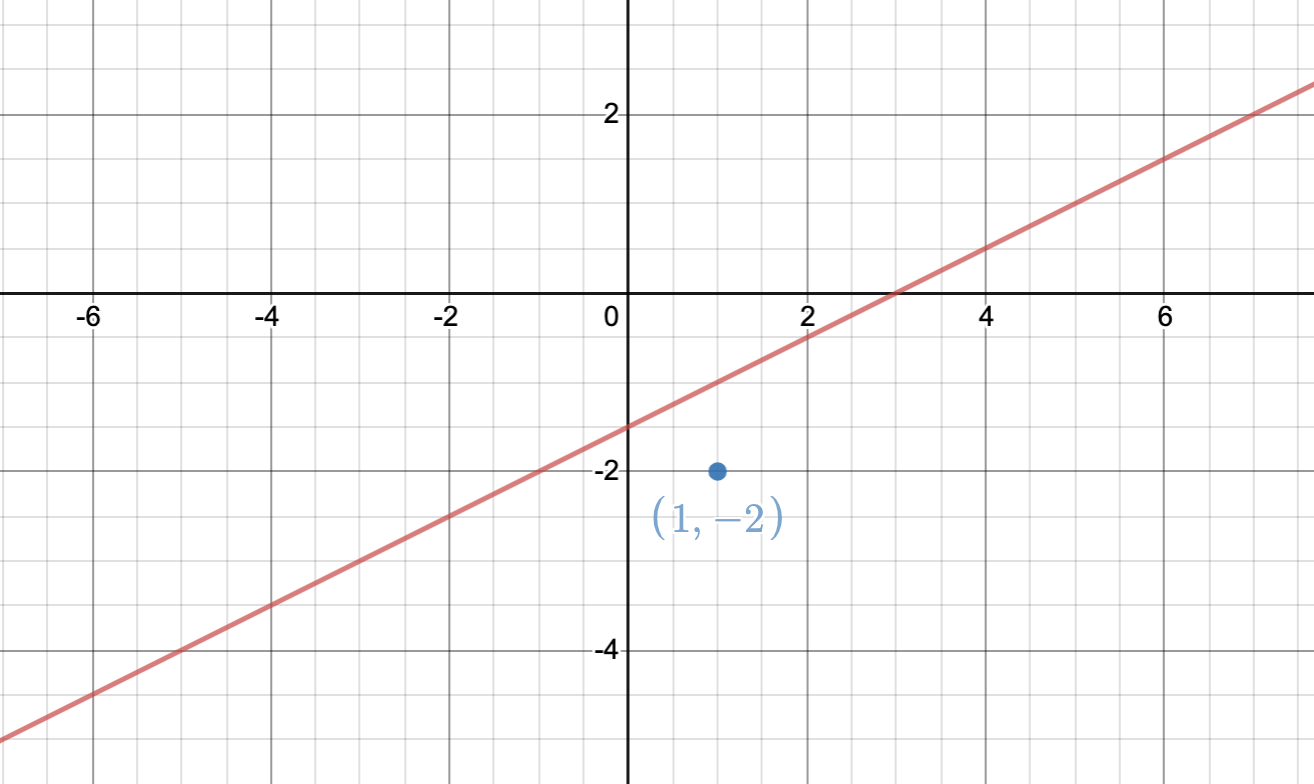
(Graph of the line $x-2y=3$ and a plot of the point $(1,-2)$ showing that it is outside the line)
$\bigstar$ An $x$-intercept is a point $(a,0)$ where the graph intersects the $x$-axis.
$\bigstar$ A $y$-intercept is a point $(0,b)$ where the graph intersects the $y$-axis.
$\bigstar$ A vertical line is a line of the form $x=k$, and a horizontal line is a line of the form $y=k$, where $k$ is a real number.
$\bigstar$ The slope of a line that passes through $(x_1,y_1)$ and $(x_2,y_2)$ is $$m =\dfrac{y_2-y_1}{x_2-x_1},$$
where $x_1\neq x_2$.
$\bigstar$ The point-slope form of a line with slope $m$ that passes through $(x_1,y_1)$ is
$$y-y_1 = m(x-x_1).$$
$\bigstar$ The slope-intercept form of a line with slope $m$ and $y$-intercept $(0,b)$ is
$$y=mx+b.$$
$\bigstar$ Parallel lines have the same slope.
$\bigstar$ The slope of a perpendicular line to a line with slope $m$ is $-1/m$.
Video Lesson
Many times the mini-lesson will not be enough for you to start working on the problems. You need to see someone explaining the material to you. In the video you will find a variety of examples, solved step-by-step – starting from a simple one to a more complex one. Feel free to play them as many times as you need. Pause, rewind, replay, stop… follow your pace!
Video Lesson
A description of the video
In the video you will see how to find:
- the slope of the line passing through $(-2,-1)$ and $(3,2)$
- the slope of the line passing through $(-3,-1)$ and $(5,4)$
- an equation for the line passing through $(-2,1)$ and $(2,-2)$
- solutions to $y+2=-\dfrac{3}{4}(x-2)$
- an equation of the line with slope $m=4/3$ that passes through $(0,2)$
- the graph of the line $y=-\dfrac{3}{2}x-2$
- an equation for the line passing through $(-2,1)$ and $(-3,-2)$
- the slope of the line with equation $3x-2y=6$
- the graph of the line $-3x+2y=6$
- an equation for the line perpendicular to $3x-2y=6$ passing through $(2,3)$
Try Questions
Now that you have read the material and watched the video, it is your turn to put in practice what you have learned. We encourage you to try the Try Questions on your own. When you are done, click on the “Show answer” tab to see if you got the correct answer.
Try Question 1
Find the slope of
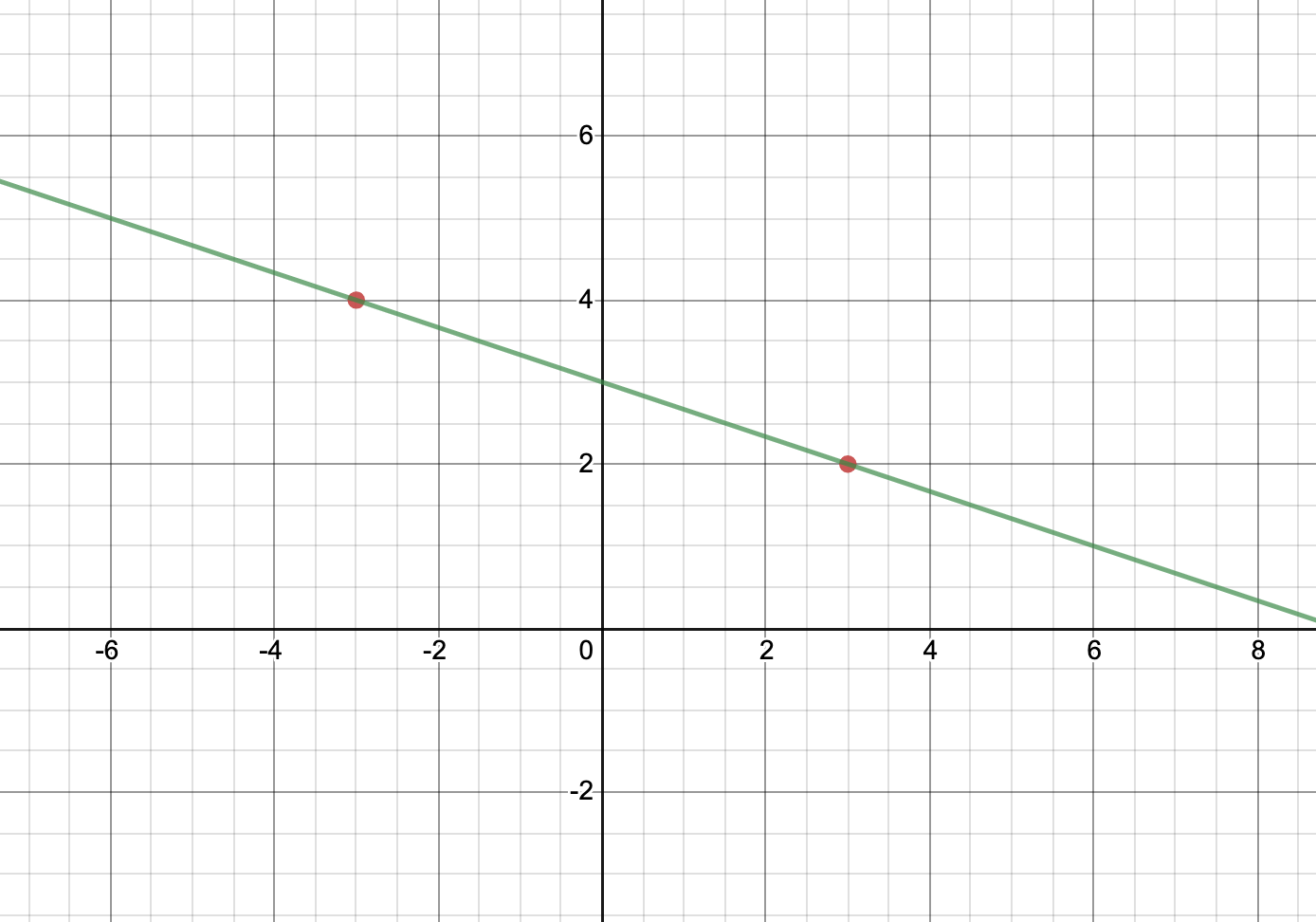
Show Answer 1
The line passes through $(x_1,y_1)=(3,2)$ and $(x_2,y_2)=(-3,4)$. The slope is
\begin{align*} m &= \dfrac{y_2-y_1}{x_2-x_1}\\ &=\dfrac{4-2}{-3-3}\\& = \dfrac{2}{-6}\\&=-\dfrac{1}{3}.\end{align*}
Try Question 2
Write an equation of the graphed line using the point-slope form.
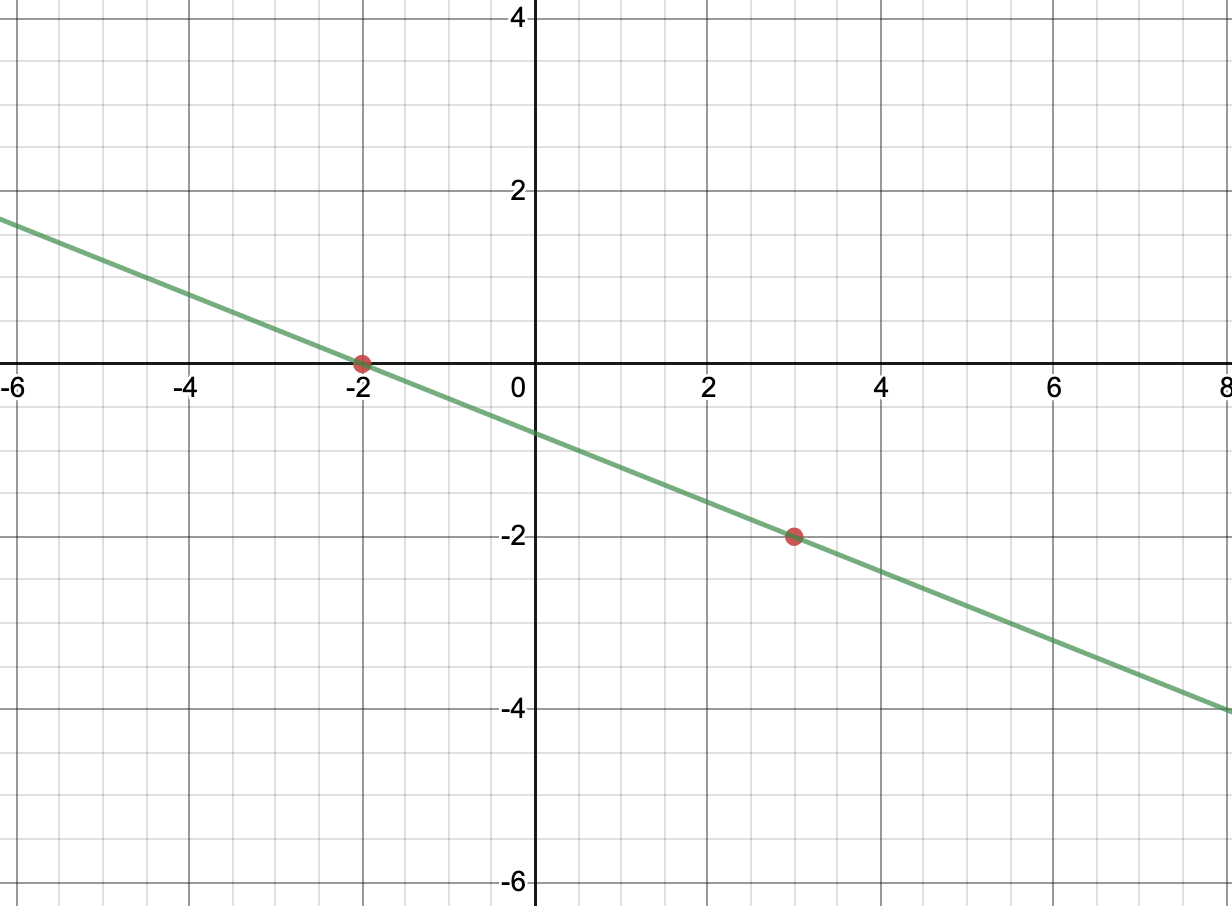
Show Answer 2
The line passes through $(x_1,y_1)=(-2,0)$ and $(x_2,y_2)=(3,-2)$. The slope is
\begin{align*}m &= \dfrac{y_2-y_1}{x_2-x_1} \\ &= \dfrac{-2-0}{3-(-2)}\\& = \dfrac{-2}{5}\\ &=-\dfrac{2}{5}.\end{align*}
The point-slope form is
\begin{align*} y-y_1&=m(x-x_1)\\ y-0&=-\dfrac{2}{5}(x-(-2))\\ y&=-\dfrac{2}{5}(x+2)\end{align*}
or
\begin{align*}y-y_2&=m(x-x_2)\\y-(-2)&=-\dfrac{2}{5}(x-3)\\ y+2&=-\dfrac{2}{5}(x-3).\end{align*}
Try Question 3
Draw a line with equation $$y-3=-\dfrac{1}{2}(x+1).$$
Show Answer 3
By setting $x=0$, we obtain that $y=5/2$, so the $y$-intercept is $(0,5/2)$.
By setting $y=0$, we obtain that $x=5$, so the $x$-intercept is $(5,0)$.
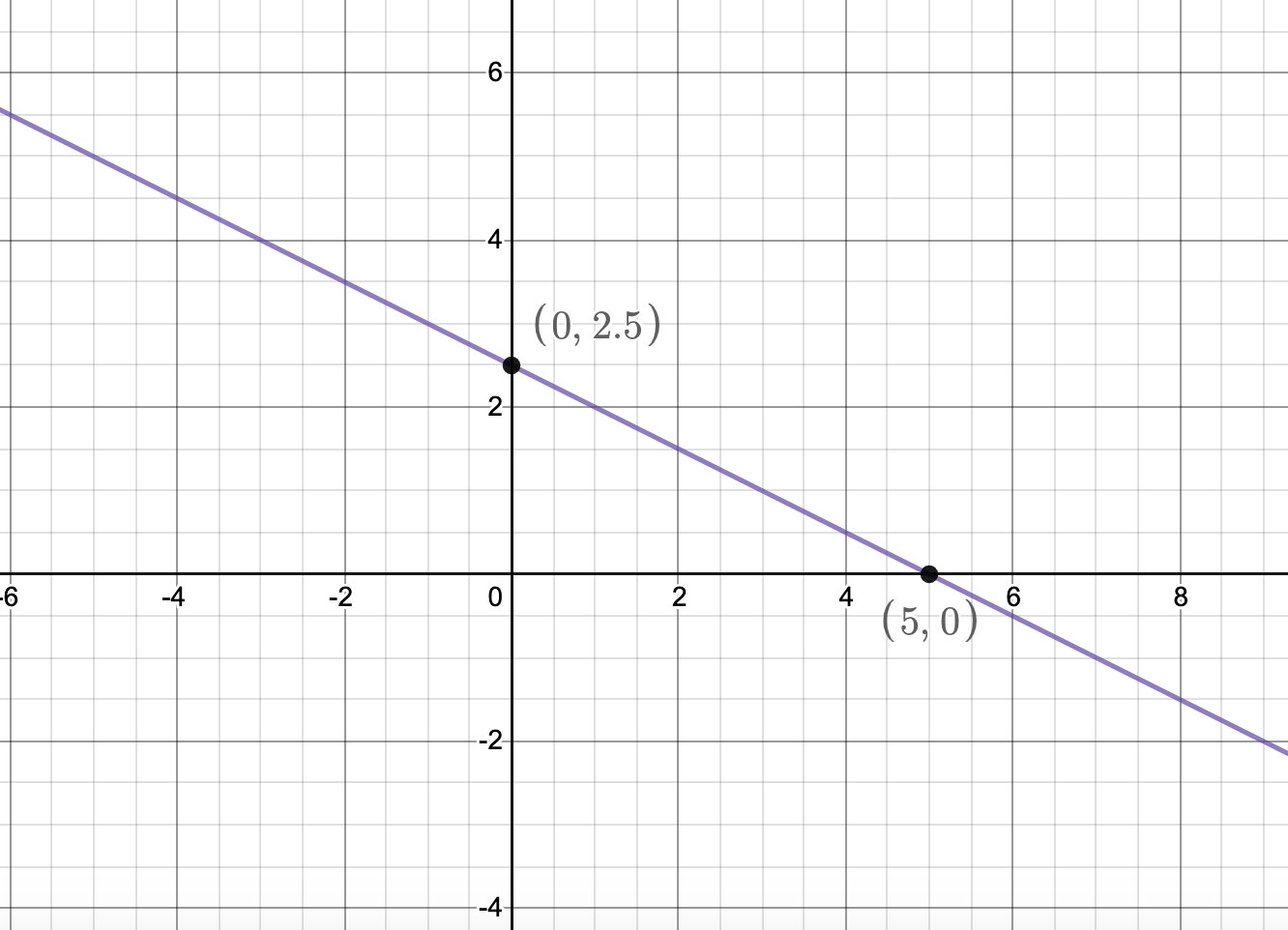
Try Question 4
Write the equation for the graph below in slope-intercept form.
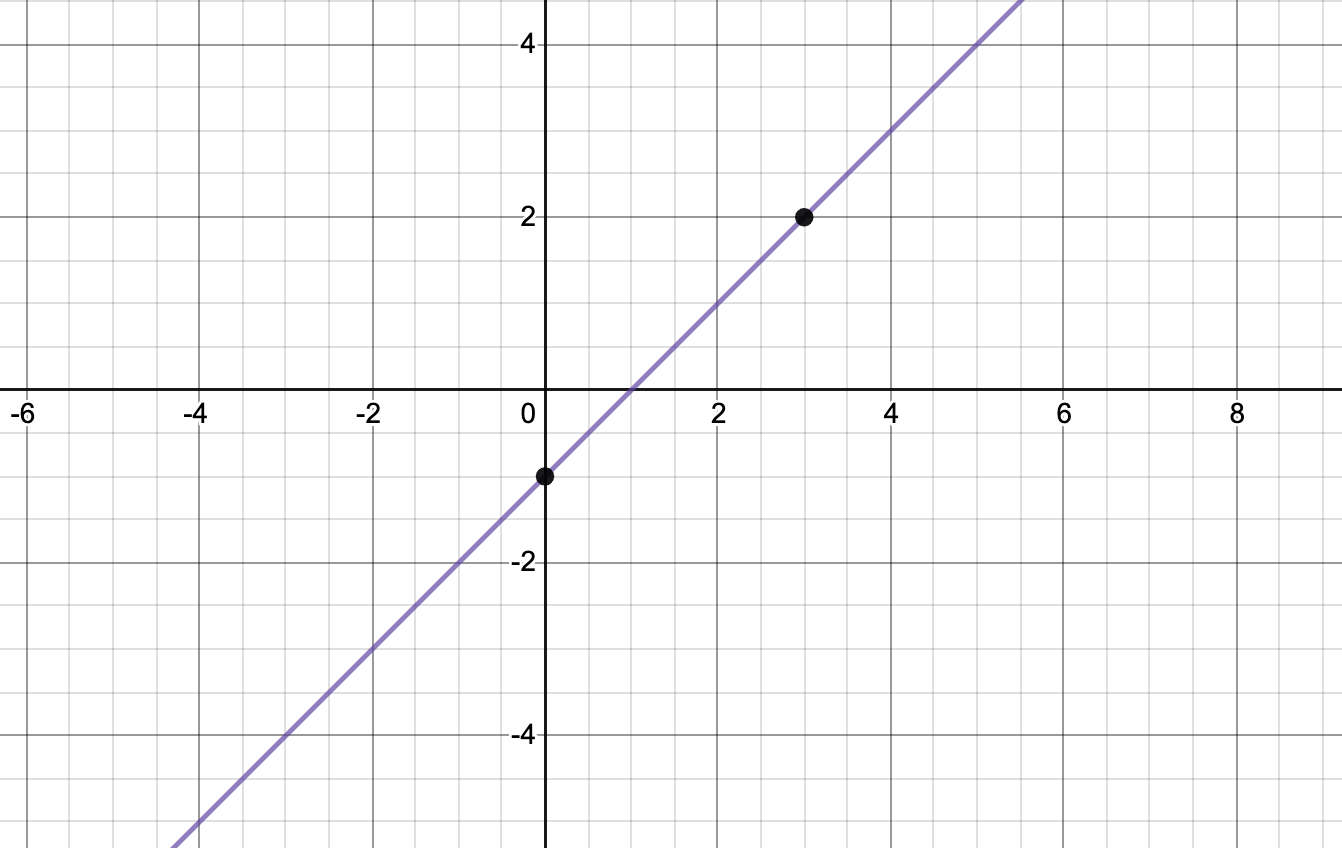
Show Answer 4
The line passes through $(x_1,y_1)=(0,-1)$ and $(x_2,y_2)=(3,2)$. The slope is
\begin{align*}m &= \dfrac{y_2-y_1}{x_2-x_1}\\ &= \dfrac{2-(-1)}{3-0}\\ &= \dfrac{3}{3}\\&=1.\end{align*}
The $y$-intercept is $(0,-1)$, so $b=-1$. The slope-intercept form is
\begin{align*}y&=mx+b\\y&=1\cdot x -1\\y&=x-1\end{align*}
Try Question 5
Graph $y=2x-1$.
Show Answer 5
When $y=2x-1$, the slope is $2$, the $y$-intercept is $(0,-1)$, and the $x$-intercept is $(1/2,0)$.

Try Question 6
Graph $y=-3$.
Show Answer 6
This is a horizontal line passing through $(0,-3)$.

Try Question 7
Write an equation in standard form for a line passing through $(1,3)$ and $(-5,2)$.
Show Answer 7
The line passes through $(x_1,y_1)=(1,3)$ and $(x_2,y_2)=(-5,2)$. The slope is
\begin{align*}m &= \dfrac{y_2-y_1}{x_2-x_1}\\&= \dfrac{2-3}{-5-1}\\& = \dfrac{-1}{-6}\\&=\dfrac{1}{6}.\end{align*}
The equation of the line is
\begin{align*}y-y_1&=m(x-x_1)\\ y-3&=\dfrac{1}{6}(x-1)\\ y-3&=\dfrac{1}{6}x-\dfrac{1}{6}\\ -\dfrac{1}{6}x+y&= 3-\dfrac{1}{6}\\ -\dfrac{1}{6}x+y&= \dfrac{17}{6}\\x-6y&=- 17\end{align*}
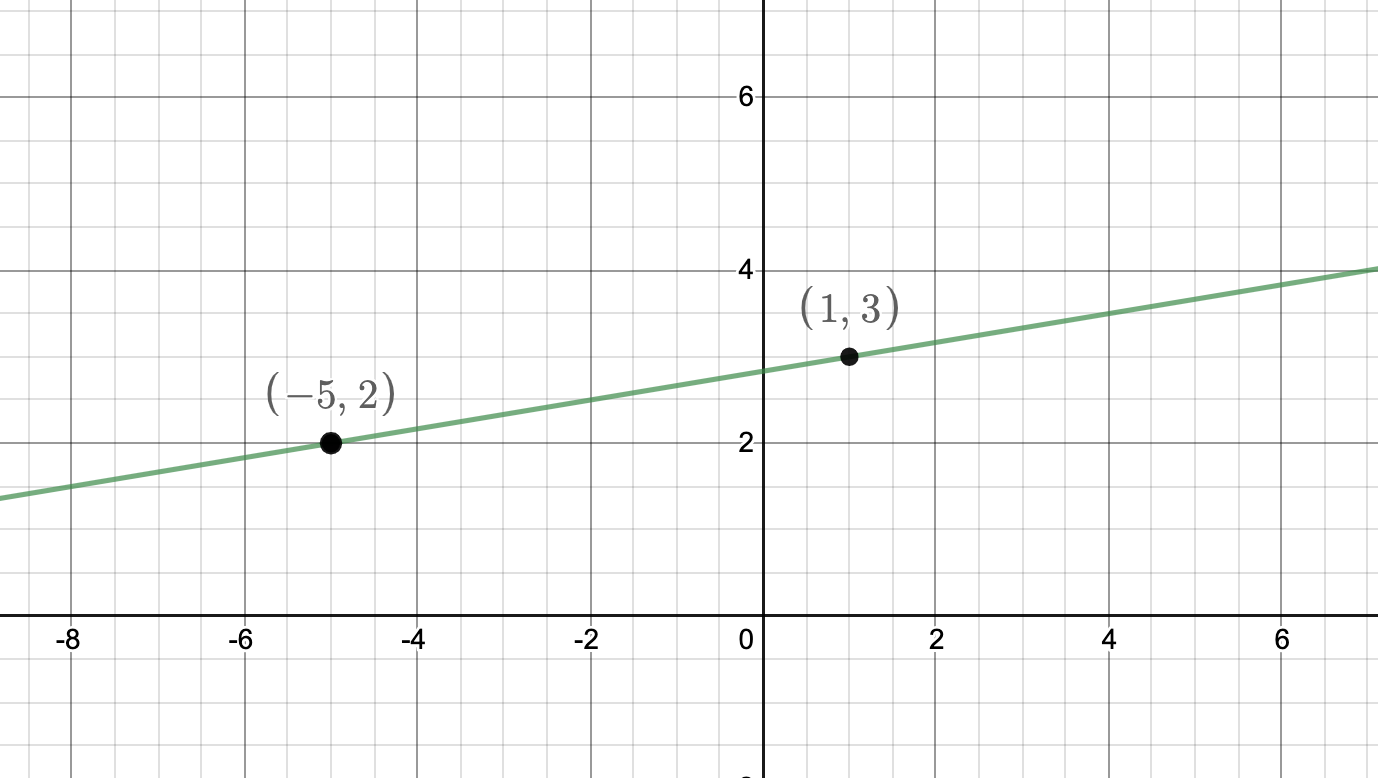
Try Question 8
Graph $y+2x=4$ by plotting points.
Show Answer 8
When $x=1$, $y=2$, so $(1,2)$ is a point on the line.
When $x=-3$, $y=10$, so $(-3,10)$ is a point on the line.

WeBWorK
You should now be ready to start working on the WeBWorK problems. Doing the homework is an essential part of learning. It will help you practice the lesson and reinforce your knowledge.
WeBWorK
It is time to do the homework on WeBWork:
LinesReview
GraphingLines
LineLab
When you are done, come back to this page for the Exit Questions.
Exit Questions
After doing the WeBWorK problems, come back to this page. The Exit Questions include vocabulary checking and conceptual questions. Knowing the vocabulary accurately is important for us to communicate. You will also find one last problem. All these questions will give you an idea as to whether or not you have mastered the material. Remember: the “Show Answer” tab is there for you to check your work!
Exit Questions
- Explain the notion of the slope and give reasoning behind the slope formula.
- How do you write a given linear equation in slope-intercept form?
- If two lines are perpendicular/parallel, what is the relationship between their slopes?
- Explain reasoning behind the midpoint formula.
- How do you graph the solutions to a linear equation in two variables if it is given in point-slope form?
- How does the information you can see from the graph inform your production of an equation whose solution is that graph?
- If a point $(2,3)$ is not on the graph of an equation, what can you say about the equation?
$\bigstar$ Write an equation for a line perpendicular to $5x-2y=6$ passing through $(-1,2)$.
Show Answer
\begin{align*}5x-2y&=6\\-2y&=-5x+6\\y&=\dfrac{5}{2}x-3\end{align*}
The slope of the line $5x-2y=6$ is $\dfrac{5}{2}$. The slope of the perpendicular line is $-\dfrac{2}{5}$. The equation of the line with slope $-\dfrac{2}{5}$ passing through $(-1,2)$ is
\begin{align*}y-2&=-\dfrac{2}{5}(x-(-1))\\y-2&=-\dfrac{2}{5}(x+1)\end{align*}
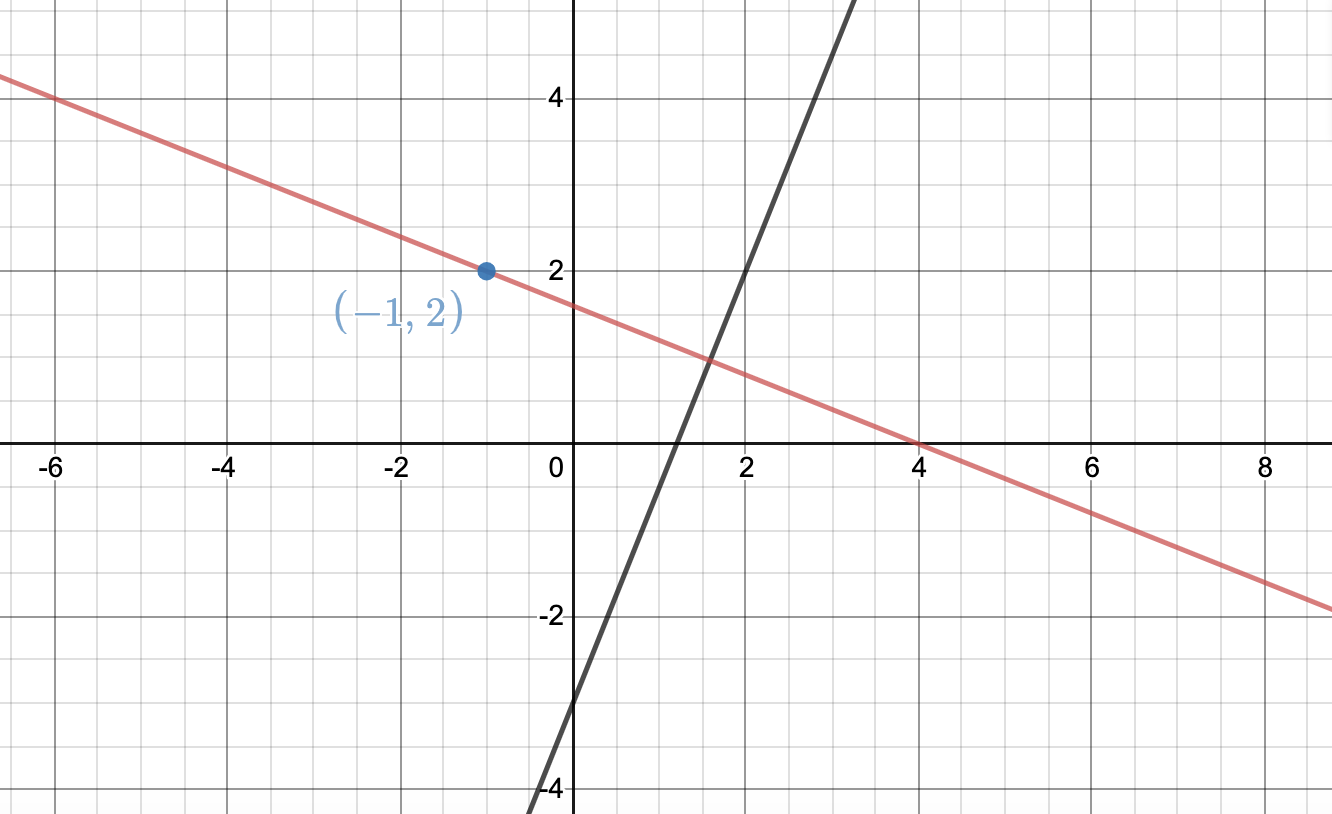
Need more help?
Don’t wait too long to do the following.
- Watch the additional video resources.
- Talk to your instructor.
- Form a study group.
- Visit a tutor. For more information, check the tutoring page.


